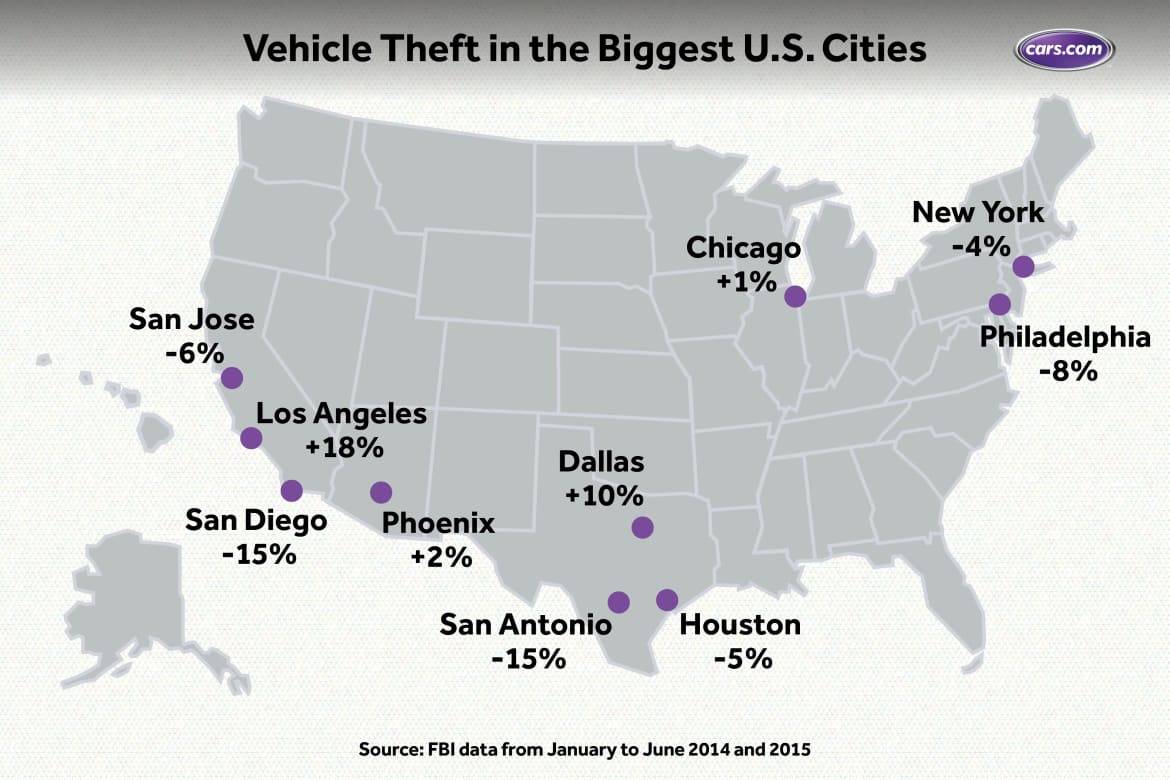Amid National Auto Theft Uptick, West Isn't Best


CARS.COM — Since auto theft’s all-time peak in 1991 with nearly 1.7 million cars stolen, thefts plummeted to less than 700,000 during the next two decades. While year-over-year upticks have occurred, 2015’s anticipated increase is notable in that it happened almost entirely in one region of the U.S., amid a renaissance of sorts for car thieves and their tactics.
Related: Which States Had the Biggest, Smallest Increases in 2015 Traffic Deaths?
According to FBI estimates for the first six months of 2015, motor vehicle theft increased 1 percent. That’s despite property crime overall — a category that also includes burglary, larceny-theft and arson — decreasing 4.2 percent for the period. The last time there was a January-to-June increase in car theft was in 2012, when it went up by 1.7 percent. But that was followed in 2013 and 2014 by dips of 3.2 percent and 5.7 percent, respectively, bringing the crime to its lowest levels in nearly a half-century.
Despite state-to-state and city-to-city variations, on a regional level the Western U.S. accounts for the entirety of the auto-theft increase. Motor vehicle theft was up nearly 6 percent in the West. That’s despite the incidence of stolen cars dipping by 5.4 percent in the Midwest, 3.6 percent in the Northeast and 0.6 percent in the South. The West’s car-theft spike was accompanied by a 2.4 percent increase in property crime overall, while the other three regions’ property-crime figures fell.
Among the biggest U.S. cities reporting crime stats to the FBI for the first six months of 2015, five of the 10 municipalities with the greatest percentage increases in auto theft were in the West. The top 10, including the number of thefts each city was up over the same period in 2014 and its percentage increase, are as follows:
10. Jacksonville, Fla.; 92 thefts; 9 percent
9. Long Beach, Calif.; 119 thefts; 11 percent
8. Dallas; 323 thefts; 10 percent
7. Atlanta; 239 thefts; 12 percent
6. San Francisco; 499 thefts; 17 percent
5. Los Angeles; 1,127 thefts; 18 percent
4. Virginia Beach, Va.; 32 thefts; 20 percent
3. Sacramento, Calif.; 260 thefts; 23 percent
2. Albuquerque, N.M.; 474 thefts; 28 percent
1. Louisville, Ky.; 356 thefts; 36 percent
“There may be local conditions that contribute to increases in certain areas — like a number of prolific thieves who are active in a given area or a reduction in law enforcement staffing or focus, which treats vehicle theft as a property crime for which a victim may be made whole again with an insurance policy,” explained Frank Scafidi, public relations director for the National Insurance Crime Bureau. “In other words, the days of having specialized auto-theft squads in most law enforcement agencies are long gone in favor of having task forces that work a variety of crimes depending on the level of criminal activity in the region.”
Scafidi said California’s dominance on the list does not surprise him, as the Golden State consistently presents a golden opportunity for car thieves. The situation in Santa Fe, N.M., is more surprising, he said, as auto theft in the first two months of 2016 is already estimated to be up 57 percent over the same period in 2015. Many of those stolen cars in Santa Fe, he noted, are older Honda Accords and Civics — both of which frequently appear on NICB’s annual list of most-stolen vehicles — which don’t have smart keys or other anti-theft technologies.
Still, as cars have become more difficult to steal, thieves have gotten cleverer in their tactics. Newfangled approaches include acquiring keys illegally by, for example, posing as a vehicle owner seeking replacement keys from a dealership; fraudulent financing through identity theft; vehicle identification number switching, in which the thief uses a “clean” VIN for an identical make and model in order to disguise a stolen car and resell it to unsuspecting buyer; and stealing rental cars by making a rental, returning the car but keeping a spare key and then stealing the vehicle later.
Despite these new methods and recent increases in auto theft, Scafidi sees a not-so-distant future where technology has rendered car thieves little more than an “occasional irritant.”
“The annual vehicle theft data is a dynamic dance — some years it’s quiet and calm while in others it can be fast and furious,” he said. “The real aspect to watch is the trend line over a stretch of time, and with a year or two of minor increases it’s not something to get too excited about.”
To that end, the biggest percentage decreases in auto theft among the nation’s largest cities reporting their crime stats to the FBI for the first half of 2015 are as follows:
5. Memphis; 153 fewer thefts; down 11 percent
4. San Antonio, Texas; 544 fewer thefts; down 15 percent
3. Wichita, Kan.; 222 fewer thefts; down 20 percent
2. Detroit; 1,353 fewer thefts; down 29 percent
1. Seattle; 933 fewer thefts; down 32 percent

Former Assistant Managing Editor-News Matt Schmitz is a veteran Chicago journalist indulging his curiosity for all things auto while helping to inform car shoppers.
Featured stories




